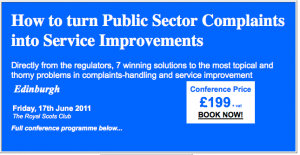How to turn Public Sector complaints into Service Improvements

We need to really think about what it means to complain. It would appear Brits need help with this - one chap who couldn't get his kettle to work set up howtocomplain.com. I think this a prime example of hitting the target but missing the point. The word complaint is corporate and negative. Don't say it.
We need to really think about what it means to complain. It would appear Brits need help with this – one chap who couldn’t get his kettle to work set up howtocomplain.com. I think this a prime example of hitting the target but missing the point. The word complaint is corporate and negative. Don’t say it.
As a service designer I design services from the point of view of the people who use them. Basically my job is to make things better so that means I am an expert in failing and failing fast. This is key when you work in the industry of problem solving. I make a living out of being empathic and this means I spend my days understanding how and why people complain about experiences.
This week I presented at “How to turn Public Sector complaints into service improvements” an event organised by 150 leading complaints practitioners around the UK. I must admit I was overwhelmed by the vast number of different approaches ranging from balance score cards to the theory of constraints. I was the only designer in the room and by far the youngest delegate. As always, I saw this as an opportunity to make a big impression.
Ronnie Hill, Head of Children’s Services at East Lothian Council was brave to announce that his organisation have only had one complaint from a young person in three years. This has to change. This service in accessible and impenetrable to the people it was designed for in the first place. East Lothian seem to be a forward thinking local authority and I was humbled my Ronnies comment to the audience after my talk “If that doesn’t inspire you – nothing will”
Jane Irvine, Chair of the Scottish Legal Complaints Commission raised some serious questions for me when advising the audience on how to deal with people who ‘enjoy complaining’ usually suffering form paranoia and suicidal thoughts.
If I could wave a magic wand I would ban the word complain and focus on the word feedback. Feedback is about listening and problem solving and I believe thats where our focus should be.
The best example I have ever seen of this idea being put into practice is on the TV show , “I’m running Sainsburies” where the Chief Executive realised that his colleagues on the shop floor were actually closest to the challenges of the business.

One worker set up a customer complaint surgery – a physical space in the shop dedicated to listening and understanding customers. He solved more than 50% of complaints in store there and then. 84% of people said they would not have used any other channel to give feedback had the complaints surgery not been there. It worked and it worked brilliantly.
There are excellent examples out there: Patient Opinion,Fix My Street,Open 311 and of course our very own MyPolice.
For me, the main conclusions were empowerment and collaboration. This stuff ain’t going to fix itself – one department can’t solve it. We need to empower people to sort things out for themselves.
The data that complaints generates needs a fresh perspective. One member of the panel asked “Who on earth could make sense of all this in their heads? My immediate thought was the process queen Sarah Drummond sat across from me right now. But seriously designers posses the skills to simplify and make sense of this stuff.
“You gave a great talk. delegates either loved it or did not get your idea. Virtually no one was luke warm which having read through thousands of these forms over the years, I think is remarkably positive. The fact you challenged the audience with a new way of operating and not everyone likes to be challenged. One said, “Loved Lauren Currie – exciting ways to hear the voice of our customers, so we learn and excel at the service we provide”
Oh, and the sooner people believe that the number of complaints do not matter – the better. The complaints process is flawed. Ultimately, services are three dimensional and designed around people. Toolkits, websites and reports are fairly useful but at the end of the day it is people who change stuff.